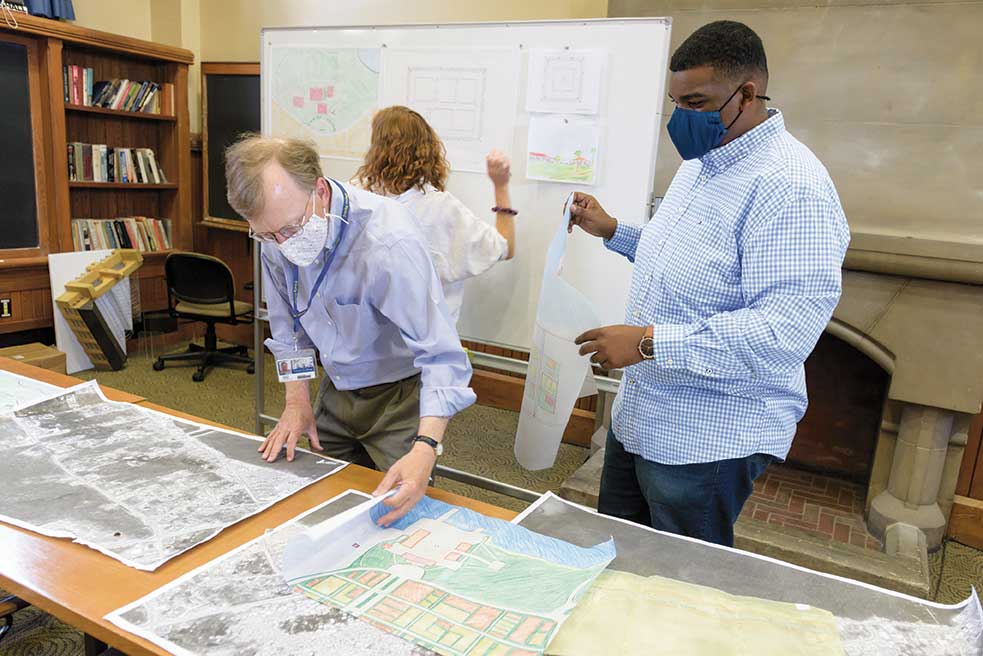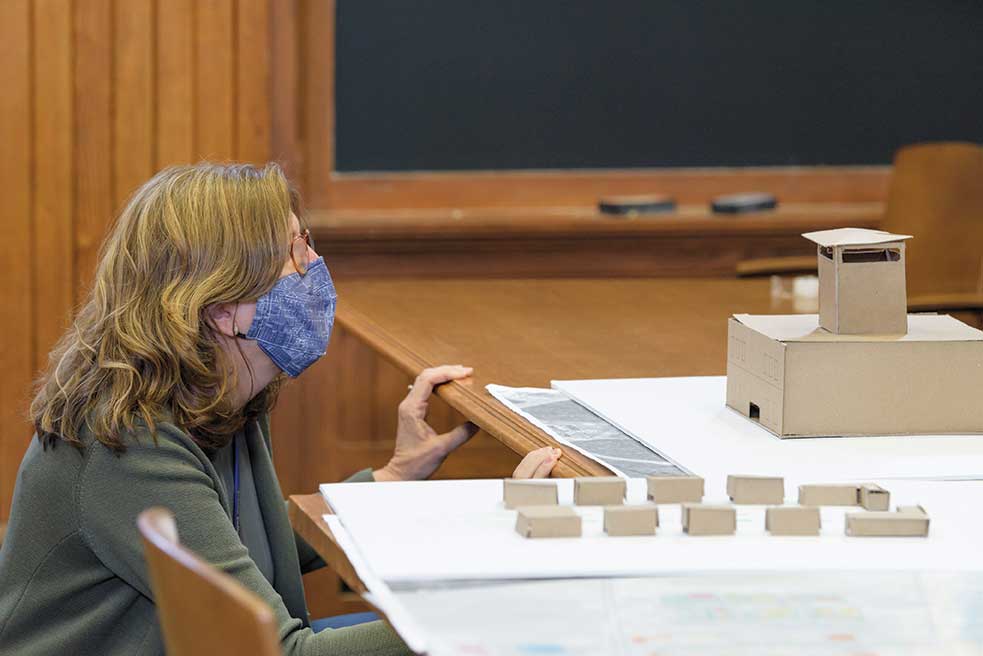‘Architectural Design’ students ‘rebuild’ storm-ravaged Bahamian town
By Andrew J. Concatelli
Classroom photos by Nick Caito
How do you rebuild a whole town whose buildings and infrastructure were blown apart and washed into the ocean by a hurricane?

That daunting challenge was the starting point for a theoretical exercise that constituted the bulk of the spring 2021 “Architectural Design” course at Trinity College. Cross-listed in the Art History Program and the Engineering Department, the course was taught by Associate Professor of Fine Arts Kristin A. Triff and Visiting Assistant Professor of Fine Arts David N. Duncan ’79, a practicing architect who recently moved his office from Connecticut to Maine.
The “Bahama Town Design” unit was inspired by a real-life tragedy: the town of Marsh Harbour suffered devastating damage in 2019 during the powerful Category 5 Hurricane Dorian, one of the worst natural disasters in the history of the Bahamas. “This exercise is not just about designing a building,” Duncan says. “It’s about this community, and it’s about how people live. We are trying to get students to think about the needs of the residents. These people’s lives were completely turned upside down by the hurricane. How do you start to rebuild, and what challenges may arise?”

Students in the class each selected specific neighborhoods along with individual buildings to design using drawing and model-building techniques. Along the way, they researched the specific requirements and conditions of the sites and learned about urban design. A major goal for the class was to work together to develop a cohesive, functional, and attractive town plan.
“Marsh Harbour is a working town that was leveled,” Triff says. “Getting our students to think about what happens after something catastrophic impacts a community—and engaging directly with that—brings out their humanity and creativity in a really positive way.”
Duncan says the project engaged the students because of its timely and topical nature. Beginning with this year’s hurricane season—which lasts from June to November—the National Oceanic and Atmospheric Administration is increasing the number of storms in what it considers an “average” season to reflect data from the last 30 years showing greater activity. “We are talking about issues of sustainability,” Duncan says. “How do we deal with hurricanes and flooding? How does one build in that environment? As one example, if you build structures the way you have to, to be above predicted storm-surge levels, they’re high off the ground. There are many implications and complications when the historic relationship of a building to the surrounding community is so dramatically altered.”

While there are no current plans for the students’ designs to be used in the town’s actual recovery efforts, the faculty and students still found value in the project. “There are all kinds of ways the students could use these thought processes,” says Duncan, who took the same course when he was a Trinity student. “Some students have never been in a design studio before, so they are essentially learning a new language and a new way to look at the world. Maybe this touches something in students that they might not know they’re interested in or have a gift for. Hopefully there will be many skills brought to bear and practiced throughout the semester that the students will find useful in their endeavors post-Trinity.”
Art history major and architectural studies minor Lillian Belletete ’21 says, “ ‘Architectural Design’ class makes you realize just how many factors go into town planning. It is easy to passively walk through cities and towns, but that is only made possible by careful planning of engineers, architects, and designers. Though I don’t want to be an architect, I think that architectural design can teach just about anyone about the process of trial and error and how to problem solve through hands-on learning.”

Belletete’s design project was a school, which she sees as an integral piece of the community that should use its natural surroundings to educate and unite the town residents. “Tourist towns such as Marsh Harbour often dedicate a great deal of their resources and assets to the tourism industry, but I think that the residents of the town deserve to enjoy the assets of the Bahamas as well,” she says. “For this reason, I placed the school by the ocean and connected it to a park, which would be open to the public in order to create a welcoming space for everyone.”
Grace Consoli ’22 says, “I chose to work on the ferry terminal area because in high school I spent a semester at sea sailing through the Bahamas. I wanted to do this section of the island to rebuild what I imagine a memorable, functional, and beautiful terminal to be.”

For Consoli—an urban studies major and architectural studies minor who plans to attend graduate school to pursue architecture—the class offered a way to combine holistic urban planning and site-specific designs. “In other classes at Trinity, we have learned what makes towns grow or fail,” she says. “This class, however, allowed me to try and imagine actually redoing and creating a new town and how to set it up for success for the residents and visitors. This included thinking about all the inner workings of a town that are usually overlooked, like street width, location of parking lots, and zoning. I’ve learned the importance of incorporating the needs of the people who live there as well as encouraging economic activity and tourism.”
With Triff teaching in the classroom and Duncan participating remotely during the COVID-19 pandemic, the class relied on innovative support from Trinity’s Library and Information Technology Services. Interactive whiteboards, microphones, cameras, and speakers allowed everyone to communicate with Duncan, who appeared on a large screen and operated a camera positioned over a design desk in his own studio.

Duncan, who is a member the American Institute of Architects and the National Council of Architectural Registration Boards, says, “I’ve tried to be a bridge between the academic world and what I do professionally. I talk about economics of architecture, construction means and materials, the process of designing a project, laws and contracts, and working with consultants. A lot of these skills have to do with communicating with other people and are very transferable. A liberal arts education gives you so many more ways to think about and interact with the world.”
Triff adds, “Urban and town planning is a broad subject for a 10-week semester. Part of what we’re trying to do is to instill critical thinking and getting students to look at alternative solutions. This bridges that gap between academic theory and lived reality, which they’ll all be doing in their future careers.”
